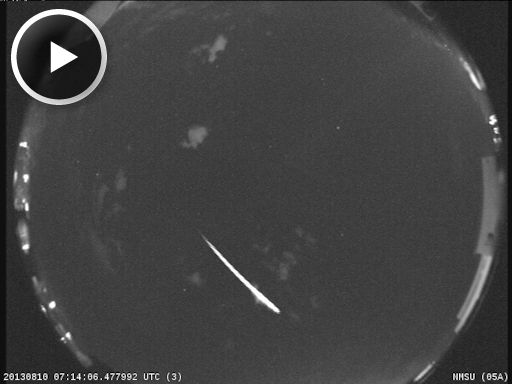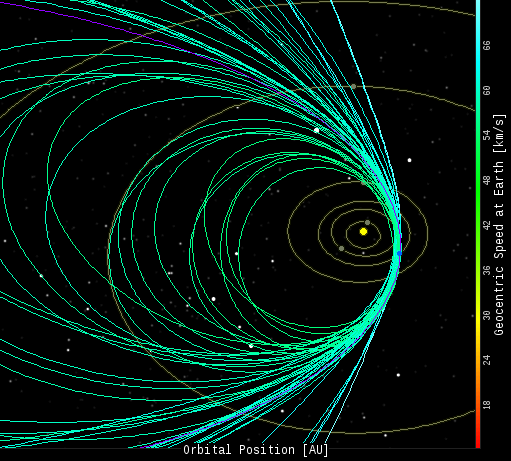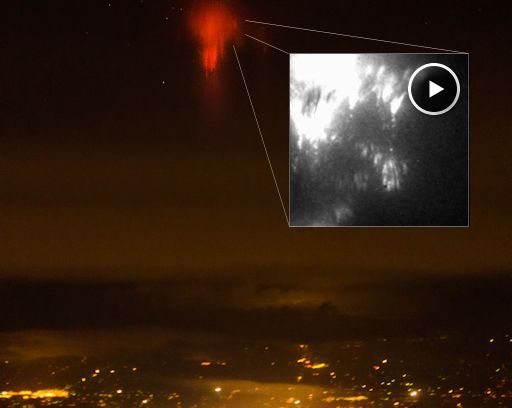Listen to radar echoes from satellites and meteors, live on listener-supported Space Weather Radio. | | |
CHANCE OF STORMS TODAY: NOAA forecasters estimate a 60% chance of polar geomagnetic storms on August 11 when a CME is expected to hit Earth's magnetic field. The incoming cloud was propelled from the sun by an erupting magnetic filament on August 8. High-latitude sky watchers should be alert for auroras. Aurora alerts: text, voice.
PERSEID METEOR SHOWER INTENSIFIES (updated): The Perseid meteor shower is intensifying as Earth moves deeper into the debris stream of parent comet 109P/Swift-Tuttle. International observers are reporting as many as 50 Perseids per hour from dark sky sites, a rate which could double on August 12-13 when the shower peaks. The best time to look is during the dark hours between local midnight and sunrise. [photo gallery] [meteor radar]
NASA's All-Sky Fireball Network recorded this bright Perseid streaking over New Mexico on the morning of August 10th:

"We have recorded dozens of Perseid fireballs in the past few nights," says Bill Cooke, head of NASA's Meteoroid Environment Office. "And we haven't even reached the peak...."
Cooke has plotted the orbits of all the recent Perseid fireballs, color-coded green in this diagram of the inner solar system:

The purple orbit traces the path of the parent comet, 109P/Swift-Tuttle. It nicely matches the orbits of the Perseids. Earth is marked by a blue dot where all the curves intersect. This diagram is going to get busier in the nights ahead, so stay tuned.
Realtime Meteor Photo Gallery
SPRITES AND JETS OVER OKLAHOMA CITY: High above Earth in the realm of meteors and noctilucent clouds, a strange form of lightning dances at the edge of space. Researchers call the bolts "sprites," and they are as beautiful as they are mysterious. Jason Ahrns, a graduate student from the University of Alaska Fairbanks, photographed a cluster of bright red sprites over Oklahoma City on August 6th. Click on the arrow to view a rare high-speed movie of the phenomenon:

"I normally study auroras," says Ahrns, "but I've become involved in sprites as a side interest." At the time of the photo, Ahrns was flying onboard a Gulfstream V operated by the National Center for Atmospheric Research (NCAR). "We try to get off to the side of sprite-producing storms, ideally about 200 km away, and film them with a couple of Phantom cameras running at 10,000 frames per second. One of the Phantoms has a diffraction grating in front of it to capture high speed spectra, which I don't think has ever been done before."
"We've also managed to record a few sprites over a lightning mapping array so we can identify the exact lightning strike that caused the sprite," he continues. "This has also never done before, and should provide insight into what type of lightning causes sprites."
"Lately," says Ahrns, "I've begun slipping my personal camera into a spare window of the airplane, and the results have been so impressive that we're planning to make a dSLR (digital camera) a regular part of future campaigns. On August 3rd I recorded some blue jets over Oklahoma city; I believe these are the first blue jets recorded by an ordinary dSLR." More tales of sprite-chasing may be found on Ahrns' personal blog.
Realtime Space Weather Photo Gallery
Realtime Aurora Photo Gallery
Realtime Noctilucent Cloud Photo Gallery
[previous years: 2003, 2004, 2005, 2006, 2007, 2008, 2009, 2011]
Realtime Comet Photo Gallery

